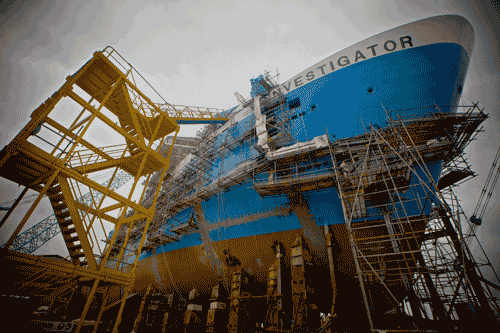A World of Ocean Research Awaits RV Investigator!

 Just over a year ago construction of Australia’s Marine National Facility research vessel Investigator began with flat sheets of steel, and now the blue-water research vessel looks amazing.
Just over a year ago construction of Australia’s Marine National Facility research vessel Investigator began with flat sheets of steel, and now the blue-water research vessel looks amazing.
To celebrate World Oceans Day on 8 June, we're releasing the time lapse of the construction of Investigator.
The Executive Director for CSIRO's Future Research Vessel Project, Toni Moated, said Investigator, is challenging the way ocean and atmospheric research has been undertaken globally, as it will support scientists across a range of disciplines – oceanographic, climate, geological, fisheries and ecosystem research.
"As much as possible, Investigator must be all things to all Australian marine scientists, as Australia has only one blue-water research vessel and this diverse and complex approach to marine and atmospheric science is unique to ocean research globally," Ms. Moated said.
The 93.9 meter Investigator has room onboard for up to 40 scientists, who can stay at sea for up to 60 days and cover up to 10 000 nautical miles in a single voyage and will replace the Marine National Facility's current vessel, Southern Surveyor, later this year when it's delivered to Hobart.
"Investigator is challenging the way ocean and atmospheric research has been undertaken globally, as it will support scientists across a range of disciplines – oceanographic, climate, geological, fisheries and ecosystem research."
Ms Toni Moate, Executive Director, CSIRO Future Research Vessel Project
The contract to design, build and commission the vessel was awarded to Teekay Holdings Australia, which partnered with Sembawang Shipyard Pte Ltd in Singapore because of its track record and strong commitment to new technologies and innovation.
"Investigator's capabilities will allow for the rapid advancement of ocean dynamics and air-sea interactions and their implications for weather and climate, and scientists will be able to accurately describe marine ecosystems and enable more effective management of biodiversity and fisheries," Ms Moate said.
The vessel's design will feature a core backbone of permanently fitted systems for sampling, data acquisition, management, and communication including winches, acoustic mapping and environmental monitoring instruments including:
a sonar and radar system housed under the ship that can map the seafloor to 7 000 meters
a deep water coring capability off the side deck which can take cores 24 meters long at a depth of 7 000 meters
The approximately 2 ton radar will gather data from storms and clouds towering 20 kilometers over the tropical ocean to cold ice storms in the Antarctic, in a 300 kilometer diameter around the ship, and it will have a broad range of research applications
The dual drop keels can deploy scientific equipment four meters below the vessel's hull, enabling acoustic instruments to be well below the bubble zone generated by the ship moving through the water
The ship is being built to comply with DNV-Silent-R, to minimize the noise from all the machinery on board. This will increase the range and resolution of seabed mapping, sub-surface imaging, and marine ecosystem monitoring instruments and it will allow scientists to provide better estimates of the number of fish and other species in the marine environment
Research teams will be able to add purpose-built systems to support their own investigations, such as radiation and trace metal laboratories, deep-water dredging, coring and drilling devices, fishing nets, towed camera systems and remotely operated vehicles.
In 2009 the Australian Government committed a$120 million to the purchase of a new research vessel for the Marine National Facility. The project is an initiative of the Australian Government being conducted as part of the Super Science Initiative and financed from the Education Investment Fund.
Sea time onboard Australia's Marine National Facility research vessel is available to all Australian scientists. The National Facility is operated by CSIRO on behalf of the nation.

